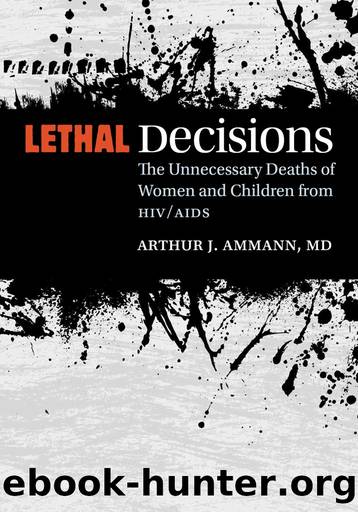Lethal Decisions by Arthur J. Ammann

Author:Arthur J. Ammann [Ammann, Arthur J.]
Language: eng
Format: epub
Tags: Social Science, Disease & Health Issues, Medical, Aids & Hiv, Health Policy
ISBN: 9780826503886
Google: RbwpEAAAQBAJ
Publisher: Vanderbilt University Press
Published: 2021-04-30T05:48:55+00:00
23
Guidelines Can Become Rules
WHO IS WHO?
WHO is viewed as the major international organization dealing with global health and responsible for developing guidelines for the prevention and treatment of disease worldwide. The organizational structure is complex and its interaction with other UN organizations confusing. Their headquarters are based in Geneva, Switzerland, with six regional offices throughout the world and 147 individual country offices. The WHO headquarters in Geneva alone include a staff of eighteen hundred workersâthere are eight thousand additional public-health experts, including doctors, epidemiologists, scientists, managers, and administrators scattered through hundreds of regional offices around the world. Its size, complexity, and insulation in decision-making have been a source of major criticism. Approximately 80 percent of WHOâs current budget comes from wealthy countries, foundations, other multilateral bodies, non-governmental organizations, and private interests, such as pharmaceutical firms. Often the donated funds come with strings attached, requiring WHO to focus on specific diseases such as malaria and polio and leaving less room for flexibility or a rapid-response structure, which perhaps explains their delays in addressing the rapidly emerging Ebola virus epidemic in 2014 (WHO 2016).1 But the slow response was not unique to Ebola; it was also evident in the emerging AIDS epidemic. An internal WHO memo in 1983, two years following the description of AIDS, stated that the organization did not need to be involved in AIDS because â[AIDS] is being well taken care of by some of the richest countries in the world where there is the manpower and the know-how and where most of the patients are to be found.â2
DONâT TREAT THEM UNTIL THEY ARE REALLY SICK
In 1997, WHO published its first, much-delayed âInformal Consultationâ on the treatment of HIV infection, which immediately sparked controversyâand with good reason. With an apparent paucity of expert scientific and economic opinion, WHO based its 1997 recommendations and its subsequently expanded 2002 guidelines on the short-term financial costs of treating millions of HIV-infected individuals. It was likely they were using what is now considered to be an outdated analysis of medical costsâcost-benefit, rather than the more realistic (and compassionate) cost-effectiveness analysis, whereby the long-range impact of investing in health care and stopping a rapidly expanding HIV epidemic is analyzed.
But the major difficulty with their guidelines was their unprecedented recommendation to treat only those individuals with advanced disease and to withhold treatment from millions of HIV-infected people. To put this into perspective, an international group of advisers headquartered in Geneva, Switzerland, with little to no responsibility for the care of patients with HIV/AIDS, no direct responsibility for their welfare or responsibility for the consequences of their decisions, assembled guidelines under which tens of millions of HIV-infected individuals worldwide should be treated, including when treatment should be started and what drugs should be used. The guidelines were meant to apply to countries affected by the HIV/AIDS epidemic regardless of the number of patients within those countries and regardless of whether the countries were economically advanced or extremely poor.
WHO treatment guidelines contrasted sharply with what was happening in practice in the United States.
Download
This site does not store any files on its server. We only index and link to content provided by other sites. Please contact the content providers to delete copyright contents if any and email us, we'll remove relevant links or contents immediately.
A Woman's Guide to Living with HIV Infection by Rebecca A. Clark & Robert T. Maupin Jr. & Jill Hayes(71)
AIDS as an International Political Issue by Peter Piot(71)
Hulda Clark The Cure for HIV and AIDS: With 70 Case Histories (Scanned Book PDF) by Hulda Regehr Clark(62)
Speech and Song at the Margins of Global Health by Steven P. Black(59)
Lethal Decisions by Arthur J. Ammann(50)
Speech and Song at the Margins of Global Health: Zulu Tradition, HIV Stigma, and AIDS Activism in South Africa by Steven P. Black(48)
Advances in HIV Treatment: HIV Enzyme Inhibitors and Antiretroviral Therapy by Gene D. Morse; Sarah Nanzigu(40)
Voices in the Band: A Doctor, Her Patients, and How the Outlook on AIDS Care Changed from Doomed to Hopeful by by Susan C. Ball(31)
Voices in the Band: A Doctor, Her Patients, and How the Outlook on AIDS Care Changed From Doomed to Hopeful by Susan C. Ball(27)
Achieving Access: Professional Movements and the Politics of Health Universalism by Joseph Harris(27)
Secretory production of hGM-CSF with a high specific biological activity by transgenic plant cell suspension culture by Unknown(16)
The relationship between fungal preservation method and secondary metabolite production in <Emphasis Type="Italic">Metarhizium anisopliae<Emphasis> and <Emphasis Type="Italic">Fusa by Unknown(16)
The Borders of AIDS: Race, Quarantine, and Resistance by unknow(15)
